Frank's travels around Britain 2011.
Cornwall.
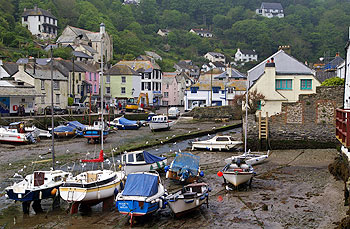 For what it's worth, take a tip & don't do Cornwall immediately after
chemotherapy, 'cos there are no flat bits in Cornwall & you'll run out of puff
for sure! Not that this isn't God's own country, & a sheer delight to collapse in,
in any given corner. (Well, maybe not Bodmin perhaps!). We picked it's most famous,
photographed, prettiest, steepest and most captivating village to stay in,
Polperro. If there is a nicer spot, we haven't found it yet. The phrases
"higgledy piggledy" & "clinging to the side of the hill" must best describe
the houses of the village. A fishing harbour from before the 13th century, it
prospered from the pilchard. These fish have been drawn to the south Cornwall
coast to feed in late summer for centuries, and these brought rich pickings for
local fishermen. Once ashore, the fish were salted and pressed and the oil was
collected as a by-product and used for heating and lighting. Polperro pilchards
were exported to many parts of Europe.
Shoals of these fish diminished in the 20th century and pilchard fishing from
Polperro died out as its mainstay in the 1960s, but nonetheless approximately
twelve commercial fishing vessels still operate from there, looking to
catch a wonderful abundance of seafood.
For what it's worth, take a tip & don't do Cornwall immediately after
chemotherapy, 'cos there are no flat bits in Cornwall & you'll run out of puff
for sure! Not that this isn't God's own country, & a sheer delight to collapse in,
in any given corner. (Well, maybe not Bodmin perhaps!). We picked it's most famous,
photographed, prettiest, steepest and most captivating village to stay in,
Polperro. If there is a nicer spot, we haven't found it yet. The phrases
"higgledy piggledy" & "clinging to the side of the hill" must best describe
the houses of the village. A fishing harbour from before the 13th century, it
prospered from the pilchard. These fish have been drawn to the south Cornwall
coast to feed in late summer for centuries, and these brought rich pickings for
local fishermen. Once ashore, the fish were salted and pressed and the oil was
collected as a by-product and used for heating and lighting. Polperro pilchards
were exported to many parts of Europe.
Shoals of these fish diminished in the 20th century and pilchard fishing from
Polperro died out as its mainstay in the 1960s, but nonetheless approximately
twelve commercial fishing vessels still operate from there, looking to
catch a wonderful abundance of seafood.
Smuggling is understood to have prospered since Polperro developed as a port in the 12th century. It reached its zenith in the late 18th century when Britain's wars with America and France precipitated the high taxation of many imported goods, making it worthwhile for the local fishermen to boost their income by the covert importation of spirits, tobacco and other goods from Guernsey. Much of the success of the smuggling trade through Polperro is ascribed to the influence of Zephaniah Job (1749–1822), a local merchant who became known as "The Smuggler's Banker". A more organised Coast Guard service was introduced in the 19th century along with stiff penalties, and led to much less smuggling.
Afternoon arrival
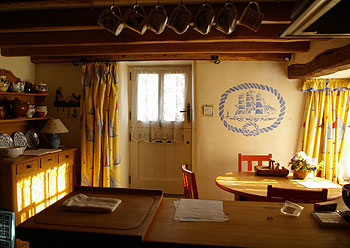 We
arrived in glorious sunshine after travelling from the Midlands. We'd stayed
overnight with our good friends John & Penny, the hosts with the most. I
needed an injection within 24 hours of receiving my chemo and Penny, being a
retired nurse, who cooks like an angel, fitted our requirements perfectly.
It split the travelling into two reasonable sized chunks & it wasn't a rush
to get there for the usual three o'clock booking in time.
We
arrived in glorious sunshine after travelling from the Midlands. We'd stayed
overnight with our good friends John & Penny, the hosts with the most. I
needed an injection within 24 hours of receiving my chemo and Penny, being a
retired nurse, who cooks like an angel, fitted our requirements perfectly.
It split the travelling into two reasonable sized chunks & it wasn't a rush
to get there for the usual three o'clock booking in time.
There was a little rain as we stopped off, en route, at Buckfast Abbey near Newton Abbott. No matter how beautiful it is, or lovely to visit, its main purpose in life is to give Frank his tonic wine. Brewed by the monks, the wine, which is still manufactured using many of the same ingredients, is based on a traditional recipe from France. The Benedictine monks at Buckfast Abbey first made the tonic wine in the 1890s. It was originally sold in small quantities as a medicine using the slogan "Three small glasses a day, for good health and lively blood". It has a dreadful reputation in Scotland as a hooligans drink! (The flaming stuff is 15% proof! What d'you expect? He wasn't fit to be breathalysed for three days!!! Cynth)
On our arrival at Polperro we were more than pleased with our allocated parking space quite near to the cottage, as parking is at a premium, if not impossible, to find.
"Harbour View Cottage" turned out to be a delight as it stood by
the slipway, bathed in sunshine. Set on three floors, it was well
laid out, full of everything you could require, & quaint, verging on twee!
Hand painted within an inch of its life, it was an emmet's delight! (emmet
is a tourist, it means ant in the Cornish language. In Devon you're a Grokel!). Entering
the cottage via its stable door, it lived up to its name as there were views
of the harbour from every room, barring the toilets. (One of which turned
out to be more of an en-suite cupboard with all mod cons. You either sit
down & do your thing, or stand up & use the sink. A brilliant bit of design
without doubt). There was a tide
clock that said it was an hour & a half off high tide, no matter what time
you checked it, but the barometer worked! The cooker
boasted a halogen hob, the shower was very good & the crockery was best
described as mixed. Books, pictures & information leaflets abounded. It h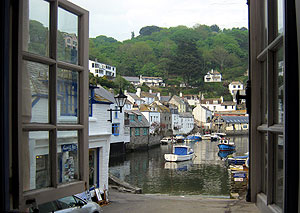 ad
the warm, welcoming feeling that lets you know instantly that its the place
for you & you're going to enjoy your stay.
ad
the warm, welcoming feeling that lets you know instantly that its the place
for you & you're going to enjoy your stay.
Right next door there was a fish & chip shop! Normally this would bring noise & smell, but none of it for us. Run by three young men from Poland, it turned out to be excellent. Our evening meal was good chips and beautiful white fish in crispy batter. Now Cynthia can't eat the batter unless it is gluten free, but in the end it looked like she'd eaten all the fish by undressing it without undoing any buttons! It was all well drained too & lovely mushy peas! Hardly cordon bleu, nor Cornish, but Great Britain on a plate, filling & satisfying, & a reasonable price. In fact, cheap by Polperro standards. We walked it off in the evening sunshine, smelling the ozone of the sea & hearing the seagulls having an occasional barney. At this time of the year, there are few late night tourists. The pubs are quiet & few shops stay open after 7pm. To have a place like this to yourself is lovely. The vessels in the harbour are a real mixture of proper working fishing boats, "half hour trips round the bay" boats & privately owned ones in a variety of sizes & shapes. One or two looked like their last trip out was to look for the Armada & their full time job was as seagull toilets.
Our first full day.
The day threatened heavy rain, and as we needed a bijou shoppette, we headed off to Looe, our nearest larger town. A huge harbour & mouth of the River Looe, it is in fact two towns connected by a bridge, East & West Looe. (Oh God, I'm beginning to sound boring again!). It has all you need on a small scale, good to shop, eat & holiday in... just not very pretty & can get very full of emmets, like all of Cornwall.
So we began our break with full shopping bags & headed towards Lanhydrock, a highly recommended National Trust property.
It's about now we should discuss new Smart phones & their effect on old men!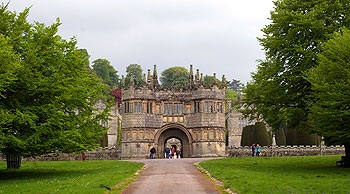
As a treat to myself, I bought a fabulous new HTC Wildfire. It has more power than Battersea power station, does more than a Nasa Space computer & looks prettier than a young Bridget Bardot. (Younger viewers may by turning away at this point). The trouble is, 72 year old men have no real idea what to do with all this technology! Determined to use its vast knowledge of Google Maps to Sat Nav his way down, Frank proved he's not the modern thrusting guy he thinks he is, and only the vast patience, understanding, & roars of laughter from Cynthia saved the entire holiday! Its brilliant but NOT dedicated like Tom Tom. It took us on a hugely enjoyable romp through lanes barely wide enough for a bike, constantly letting us know it had lost its GPS but never failing to end up at your selected destination .... eventually! There are times when you do not trust it & decide you know best. It happened at Lanhydrock! Beware old men who can't walk too far. The Wildfire was right & I suffered from "I know best" ignorance!
With Cynthia on the verge of wetting the car seat with laughter, & me trying to prove I was a real man who burned his maps now cos of modern technology, we approached a car park for Lanhydrock, while precisely at that moment, Gladys, with her electronic gravelly voice said "Turn right & you will reach your destination in half a mile". "What nonsense! Look here's the car park!" says Frank. Cynthia never said a word. She KNEW her Tom Tom wasn't THIS stupid. Anyway to cut a long story short, Gladys was directing us to the top car park that is very near the house, while the ancient one & his caring nurse tried to get up this long hill without needing oxygen as he suffered from altitude sickness & was threatening a massive coronary! Thank god they serve good coffee in NT cafes as that was our first port of call.
The best thing to happen to National Trust properties is giving permission to photograph the interiors so long as you don't use flash. It has transformed the visit for all of us I think.
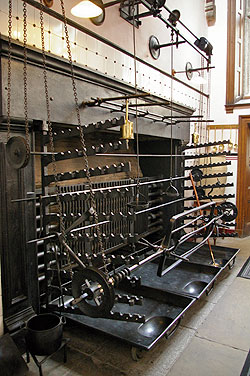 Lanhydrock estate belonged to the Augustinian priory
of St Petroc at Bodmin,
but the Dissolution of the Monasteries during the 1530s saw it pass into private
hands. In 1620 wealthy merchant Sir Richard Robartes acquired the estate and
began building Lanhydrock House, designed to a four-sided layout around a
central courtyard and constructed of grey granite.
Robartes died in 1624 but work on the building was continued by his son John
Robartes, 1st Earl of Radnor. During the 18th century the east wing of
the house was demolished leaving the U-shaped plan seen today. In 1881 a
major fire destroyed the south wing and caused extensive damage to the
central section. Of the main house only the north wing, with its 29 m Long
Gallery, and the front porch building, survived intact, though the original
gatehouse also dates back to the mid 17th century.
Lanhydrock estate belonged to the Augustinian priory
of St Petroc at Bodmin,
but the Dissolution of the Monasteries during the 1530s saw it pass into private
hands. In 1620 wealthy merchant Sir Richard Robartes acquired the estate and
began building Lanhydrock House, designed to a four-sided layout around a
central courtyard and constructed of grey granite.
Robartes died in 1624 but work on the building was continued by his son John
Robartes, 1st Earl of Radnor. During the 18th century the east wing of
the house was demolished leaving the U-shaped plan seen today. In 1881 a
major fire destroyed the south wing and caused extensive damage to the
central section. Of the main house only the north wing, with its 29 m Long
Gallery, and the front porch building, survived intact, though the original
gatehouse also dates back to the mid 17th century.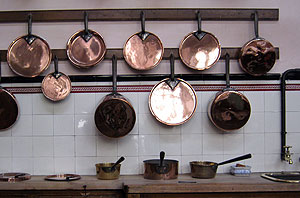 (I can see you yawning, dear reader. Never fear it does get better...honest!
Cynth)
(I can see you yawning, dear reader. Never fear it does get better...honest!
Cynth)
The whole house is well displayed. The kitchen & servants are given as much attention to detail as the owners quarters. There is much to see in the interior & you come away realising that plenty of muscle power was needed from many staff to keep the few in the luxury they could afford. Nothing is on a small scale, with many to feed & most things man powered, even the copper bowls & hand whisks were huge. If nothing else, you needed to be fit to work there & no matter how many calories you consumed, they were soon burnt off! The size & complexity of the fireplace is amazing. Designed to cook food at all distances from the open flame or burning ember, the skill the cooks used to do what we do by dialing 8 on our gas ovens must have been priceless. Just looking at it makes you assume that most cooking was done in a rotary motion.
Being an ex nanny, Cynthia felt very at home in the nursery, but thought this world was best left in the past & she was relieved to have had the modern new fangled ways she knew! Frank could only cast envious eyes on the cigars in the smoking room .... its been a long time since he spent an hour & a half burning very fragrant Cuban cigars at vast expense.
After the long climb to the house & doing two floors I had to give in & miss the servants quarters on the top floor. It was time to call it a day. Out of breath, tired to the point of feeling exhausted & craving more energy than I could muster, I began to realise that there was no way this holiday was going to be completed alive unless I could pace myself & stop trying to be indestructible. Whether this type of chemo made me more breathless or whether I tried to do too much too soon is debatable. This treatment was certainly different to my original chemo. We just beat a retreat to Polperro (via strange ways according to Gladys) & collapsed in a heap for the rest of that night.
Monday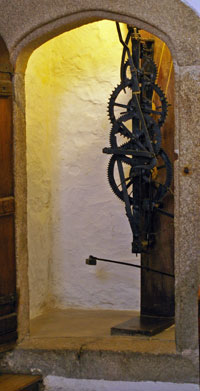
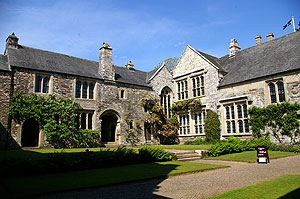 Today
was a Bank Holiday & we were expecting the roads & towns to be packed but it
was fine, no hold ups nor lack of parking.
Today
was a Bank Holiday & we were expecting the roads & towns to be packed but it
was fine, no hold ups nor lack of parking.
We chose Cotehele as our next house to visit. Maybe Lanhydrock was better at informing us or Cotehele was far too dark, as it protected its many tapestries, but we didn't take to the house much at all.
The Medieval manor house at Cotehele, has buildings which are as they were in the 16th century — it is one of the least altered medieval houses in Britain, with very little improvements, or changes, to the structure since the improvements by Sir Richard Edgecumbe and his son at the end of the 15th century.
Most of the original furnishings and tapestries remain at the house. Each room has its own example of a tapestry, all very dark & somber. You enter the buildings via the Great Hall and you immediately walk into a display of arms and armoury, set amongst a collection of period furniture and tapestries beneath the a high, arched, timber roof. There doesn't seem to be a theme nor much information that we could readily absorb. Maybe it was our fault & we missed it's finer points. Cotehele has three internal courtyards and a splendid old kitchen and a tower. The tower was added in 1627, providing the House with three impressive bedrooms. King Charles I is said to have stayed the night here. The chapel clock installed in 1489 is a great rarity. It is pre-pendulum and is powered by two 90 pound weights.
As we were very close to my sister Irene & her husband Jim at Newton Abbott, and a friend called Andy, who lives in Teignmouth, (not forgetting Odo the dog), we spent a very pleasant afternoon catching up with the chat & gossip, & drinking coffee in Devon with great pleasure. It is noted that to go to Cornwall is free across the Tamar Bridge but when you come back to Devon, there is a £1:50 toll! Well worth it, I might add.
I was still very tired but we had paced ourselves better & I was coping OK.
Tuesday
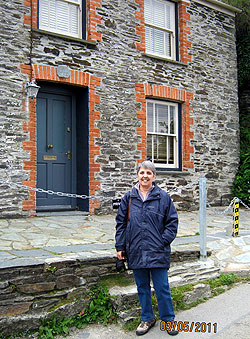 After
a nights rest I was too keen to get off onto the road again. We needed a
Barclays Bank & as there was one in Bodmin, it was our first port of call.
Whoops! Sorry Bodmin, we may have caught you on a bad day! Scruffy, boarded
up shops & just one obvious centre meant we decided to move on quickly.
After
a nights rest I was too keen to get off onto the road again. We needed a
Barclays Bank & as there was one in Bodmin, it was our first port of call.
Whoops! Sorry Bodmin, we may have caught you on a bad day! Scruffy, boarded
up shops & just one obvious centre meant we decided to move on quickly.
Neither Cynthia nor I are great TV fans but we both like Doc Martin, so it was over to Port Isaac where much of it is filmed. It was nearly 50 years since my last visit but little has changed. Why alter something the folks want to see?
The Port Isaac pier was constructed during the reign of Henry VIII. The village's central precinct dates from the Eighteenth and Nineteenth centuries, from a time when it's prosperity was tied to local coastal freight and fishing. The port handled cargoes such as coal, wood, stone, ores, limestone, salt, pottery and heavy goods which were conveyed down its narrow streets. Fishermen still work from the Platt, landing their daily catch of fish, crab and lobsters. Frank even had £2 worth of the local seafood .... oooh delicious!
About half way down the road from the top car parks, some very nice people have opened a bright & breezy cafe as the official Doc Martin souvenir shop. I just hope they do well. Bags of enthusiasm & very cheerful, they welcome one & all ... even the Doc Martin weirdo's! I'm sure, as the season gets under way there will be Doc Martin tours & each cast member will have a drink named after them in the local ale house. Good luck to the whole village, I hope it draws in bus loads for you.
As I continued to run out of steam, we slowly wound our way back via a
few very attractive stop off points. Once again we used some very strange
roads as Gladys lost GPS signals & showed us a LOT of Dartmoor, some of
which was not on our schedule. Cynthia can map
read well & was in stitches at the routes she took us on. Who cares when you're on
holiday? Anyway, you can't get lost if you don't know where your going.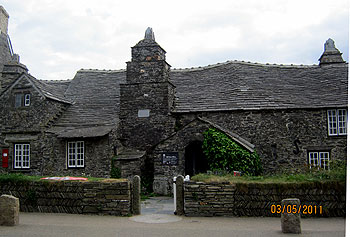 (Trouble is, we knew where we were hoping to go and
when Gladys had taken us in a complete circle and then headed back where
we'd come from, MY Tom Tom finally saved the day. Up yours Gladys!
Cynth)
(Trouble is, we knew where we were hoping to go and
when Gladys had taken us in a complete circle and then headed back where
we'd come from, MY Tom Tom finally saved the day. Up yours Gladys!
Cynth)
Finally we made it to Tintagel, the sort of Glastonbury of Cornwall. The whole place promotes the Arthurian legend of Kings & knights & round tables & the magic of Merlin. The castle is out by the cliffs & is hard work to get to ... unless you pay a Landrover to take you there!
There is a very nice place called the Old Post Office, belonging to the National Trust. The building is typical of many late medieval manor houses with a central single-storey hall open to the roof, flanked by smaller service rooms and a kitchen (now the parlour) with bedrooms above. The Old Post Office came to the National Trust empty of contents, apart from a late medieval kitchen table situated in the Hall. The rooms have been furnished with items from farmhouses and cottages in the vicinity. One of the rooms remains as a Victorian village post office, and outside on the wall is an example of the first standard wall letter box of 1857. Only 14 such boxes remain in existence – mostly in the south and west of England. This particular box is characterised by having no hood over the aperture and its door sited in the middle.
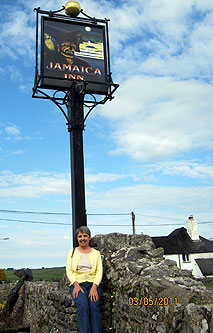 So Gladys led us on her merry dance across Dartmoor, finally arriving at
Jamaica Inn. The inn is famous for being the base of smugglers in
the past and has gained national renown for allegedly being one of the most
haunted places in Great Britain. It is also known as the setting for Daphne
du Maurier's novel
of the same name, published in 1936. The
young author at the time was inspired to write her novel when, having gone
horse riding on the moors, she became lost in thick fog and sought refuge at
the inn in 1930. During
the time spent recovering from her ordeal, the local rector is supposed to
have entertained her with ghost stories and tales of smuggling; he would
later become the inspiration for the enigmatic character of the Vicar of Altarnun.
The novel was made into the film Jamaica
Inn in 1939 by Alfred
Hitchcock.
So Gladys led us on her merry dance across Dartmoor, finally arriving at
Jamaica Inn. The inn is famous for being the base of smugglers in
the past and has gained national renown for allegedly being one of the most
haunted places in Great Britain. It is also known as the setting for Daphne
du Maurier's novel
of the same name, published in 1936. The
young author at the time was inspired to write her novel when, having gone
horse riding on the moors, she became lost in thick fog and sought refuge at
the inn in 1930. During
the time spent recovering from her ordeal, the local rector is supposed to
have entertained her with ghost stories and tales of smuggling; he would
later become the inspiration for the enigmatic character of the Vicar of Altarnun.
The novel was made into the film Jamaica
Inn in 1939 by Alfred
Hitchcock.
It is often commonly thought that the inn takes its name from the smugglers who smuggled rum into the country from Jamaica and stored it at the inn. However, the name of the inn is actually said to derive from the important local Trelawney family of landowners, of which two family members served as Governors of Jamaica in the 18th century. The inn was built in 1750 and extended in 1778 with a coach house, stables and a tack room assembled in an L-shaped fashion. The inn became a smugglers' stopping point while they used approximately 100 secret routes to move around their contraband. Originally, the half-way house was alone on this part of the moor, but later a church, parsonage, and school were added by Mr. Kodd, the proprietor of the land, satisfying the area's residents. According to narrated story, piratical gangs operated on the coast of Cornwall during early 19th century. Cornwall has been very aptly described as the “haven of smugglers” in view of its topographic features of “rocky coves, sheltered bays, tumultuous waves and wild and untenanted landscapes”. The pirates ensnared ships to this coast line by tricking them with use of beacon lights, which they purposefully installed on the shores of the coast. Once the ships hit the rocky coast, they were wrecked and looted by the pirates.
Wednesday
Up to now we had had very mixed weather. We never actually got wet through & when the sun came out it was glorious. Today we decided to head south, over the Fowey Ferry, via Truro and on to St. Michael's Mount. By the time we were ready to board, the sun lit up Fowey & the river. It was just lovely.
This medieval town has a natural harbour that allowed trade to develop
with Europe and local ship owners often hired their vessels to the king to
support various wars, although the town also developed a reputation for piracy,
as did many others at this time. In the fourteenth century the harbour was
defended by 160 archers; after these were withdrawn, two blockhouses were
built on either side of the harbour entrance. (Oh gawd he's off again.
Yawn... Get on with it Frank! Cynth)!Despite these defences the
town was attacked by French forces in 1457. A small castle was built on St
Catherine’s Point, the western side of the harbour entrance, around 1540.
The defences proved their worth when a Dutch attack was beaten off in 1667. The people of Fowey generally sided
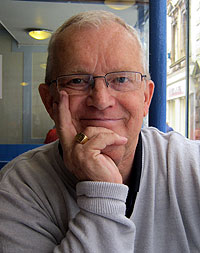 with the Royalists during the English
Civil War, but in 1644 the Earl
of Essex brought a Parliamentarian army to Lostwithiel and
occupied the peninsula around Fowey. In August a Royalist army surrounded
Essex’s troops and King
Charles I himself viewed Fowey from Hall Walk above Polruan, where he
came close to being killed by musket shot.
with the Royalists during the English
Civil War, but in 1644 the Earl
of Essex brought a Parliamentarian army to Lostwithiel and
occupied the peninsula around Fowey. In August a Royalist army surrounded
Essex’s troops and King
Charles I himself viewed Fowey from Hall Walk above Polruan, where he
came close to being killed by musket shot.
Being extra English & eccentric, the town is pronounced Foy .... and why not? Another local legend is shared with Glastonbury, that Jesus visited Fowey as a child, along with Joseph of Arimathea who was a merchant visiting local tin mines in which he had a commercial interest. Now you can't say that that's not an interesting & varied history! (Yes I can. "History is more or less bunk" Henry Ford (May 25 1916)..."I agree" Cynthia, May 13 2011!)
When we reached Truro (quite a nice City with a large cathedral), Gladys
decided to take the mick again. She has a very useful application that
remembers where you left your car & no matter where you go, it guides you
back. Wrong! We stepped out in lovely sunshine, no buildings around us &
Gladys said she was dreadfully sorry but she had no GPS signal & could I try
later! It was at this point Cynthia said she'd never heard that
word before, & could I explain its origins & meaning. We had a very nice
simple lunch in a cafe by the cathedral & briefly walked around town & then
moved on.
St. Michael's Mount is glorious & looks like a mirror image of Holy
Island at Lindisfarne at the other end of the country. Historically, St
Michael's Mount was actually the Cornish counterpart of Mont Saint-Michel,
Normandy, France, when it was given to the Benedictines, religious order of
Mont Saint-Michel, by Edward the Confessor in the 11th century. Just reading
about this magical place made me regret this illness that stopped us climbing up into the castle. It
is truly steeped in the earliest times. It's Cornish language
name-—literally, "the grey rock in the wood"-—may represent a folk memory of
a time before Mount's Bay was
flooded. Certainly, the Cornish name would be an accurate description of the
Mount set in woodland. Remains of trees have been seen at low tides
following storms on the beach at Perranuthnoe,
but radiocarbon
dating established the submerging of the hazel wood at about 1700 BC. The
chronicler John of
Worcester relates
under the year 1099 that St.
 Michael's Mount was located five or six miles
from the sea, enclosed in a thick wood, but that on the third day of the nones of
November the sea overflowed the land, destroying many towns and drowning
many people as well as innumerable oxen and sheep; the Anglo-Saxon
Chronicle records under the date 11 November 1099, "The sea-flood sprung
up to such a height, and did so much harm, as no man remembered that it ever
did before".
Michael's Mount was located five or six miles
from the sea, enclosed in a thick wood, but that on the third day of the nones of
November the sea overflowed the land, destroying many towns and drowning
many people as well as innumerable oxen and sheep; the Anglo-Saxon
Chronicle records under the date 11 November 1099, "The sea-flood sprung
up to such a height, and did so much harm, as no man remembered that it ever
did before".
We took endless photographs, loved the walk over the causeway & into the lower part of the island itself. On a well deserved rest stop in the cafe, I made a right pig of myself eating a Cornish Cream tea!
By the time we walked out to return to the main land, the tide was in & we took the "water taxi" back across the bay. It was just delightful and there is no doubt, if I'm around long enough & fit enough, it will be a place to return to & spend time absorbing this fascinating idyll.
Thursday
By this time we were doing things in small bites! I was still doing & seeing lots but I soon found I felt worn out. Never a complaint from Cynth, she was still enjoying Cornwall no matter where we went & no matter how slowly we walked nor how many rest stops we took. We did make one mistake though! I knew that the big trading company, Trago Mills was famous for inexpensive goods thoughout the South West. I thought it was a leisure & shopping centre. Well it was a centre OK and it looks very interesting from the outside as you come in to park, but a scruffier place I cannot remember. Maybe we are used to bargains in the North but its reputation for keen prices failed to impress us. There is a distinctive anti-government feel about the statues adorning the outside. This is because the owner belongs to the UKIP party apparently! It was a strange place & we didn't stay long!
 Our
last place we had planned to visit ran second only to St. Michael's Mount. Bucklands Abbey
was the home of Sir Richard Grenville and later, of Sir Francis Drake. A most
informative place to visit & full of interest.
Our
last place we had planned to visit ran second only to St. Michael's Mount. Bucklands Abbey
was the home of Sir Richard Grenville and later, of Sir Francis Drake. A most
informative place to visit & full of interest.
Buckland was originally a Cistercian abbey founded
in 1278 by Amicia, Countess of Devon and was a daughter house of Quarr Abbey, on the Isle
of Wight. It remained an abbey until the Dissolution
of the Monasteries by King
Henry VIII. (uh oh here he goes again. Bear with him though reader
because this was a very interesting place.
Cynth) In 1541 Henry sold Buckland to Sir Richard Grenville who,
working with his son Roger, began to convert the abbey into a residence.
Roger died in 1545, leaving a son, also named Richard
Grenville, who completed the conversion. He eventually sold Buckland to
Drake in 1581. The abbey is unusual in that the church was retained as the
principal component of the new house whilst most of the remainder was
demolished, which was a reversal of the normal outcome with this type of
redevelopment.
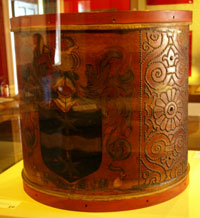 Sir Francis Drake, Vice
Admiral (1540 – 27 January 1596) was an English sea
captain, a privateer, navigator, slaver,
a renowned pirate, and a
politician of the Elizabethan
era. Elizabeth
I of England awarded Drake a knighthood in 1581. He was
second-in-command of the English fleet against the Spanish
Armada in 1588, subordinate only to Charles
Howard and the Queen herself. He died of dysentery in
January 1596 after
unsuccessfully attacking San
Juan, Puerto Rico. His exploits were legendary, making him a hero to
the English but a pirate to
the Spaniards, to whom he
was known as El Draque, 'Draque' being the Spanish pronunciation of 'Drake'.
His name in Latin was Franciscus Draco ('Francis the Dragon'). King Philip
I was claimed to have offered a reward of 20,000 ducats, about £4,000,000
by modern standards, for his life. He is famous for (among
other things) leading the first English circumnavigation of
the world, from 1577 to 1580.
Sir Francis Drake, Vice
Admiral (1540 – 27 January 1596) was an English sea
captain, a privateer, navigator, slaver,
a renowned pirate, and a
politician of the Elizabethan
era. Elizabeth
I of England awarded Drake a knighthood in 1581. He was
second-in-command of the English fleet against the Spanish
Armada in 1588, subordinate only to Charles
Howard and the Queen herself. He died of dysentery in
January 1596 after
unsuccessfully attacking San
Juan, Puerto Rico. His exploits were legendary, making him a hero to
the English but a pirate to
the Spaniards, to whom he
was known as El Draque, 'Draque' being the Spanish pronunciation of 'Drake'.
His name in Latin was Franciscus Draco ('Francis the Dragon'). King Philip
I was claimed to have offered a reward of 20,000 ducats, about £4,000,000
by modern standards, for his life. He is famous for (among
other things) leading the first English circumnavigation of
the world, from 1577 to 1580.
Sir Francis Drake lived in the house for 15 years, as did many of his collateral descendants until 1946, when it was sold to a local landowner, Arthur Rodd, who presented the property to the National Trust in 1948.
Inside the house are many excellent objects well shown & noted. Drake’s Drum is just one. It is a snare drum that Sir Francis Drake took with him when he circumnavigated the world. Shortly before he died he ordered the drum to be taken to Buckland Abbey, where it still is today, and vowed that if England was ever in danger someone was to beat the drum and he would return to defend the country. According to legend it can be heard to beat at times when England is at war or significant national events take place. His flags also adorn the walls but there are two huge sculptures to be seen, a gigantic statue of Drake himself & the "A Royal Game" by Sir William Reynolds-Stephens.
T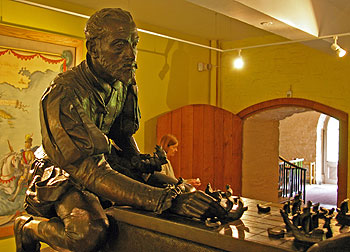 he plaster statue by Sir Joseph Boem
was exposed to the elements for over 50 years and arrived at Buckland in
2002. It has only just arrived back after further repair work to a leg. To give you an idea of its size, Cynthia is 4'
11"!
he plaster statue by Sir Joseph Boem
was exposed to the elements for over 50 years and arrived at Buckland in
2002. It has only just arrived back after further repair work to a leg. To give you an idea of its size, Cynthia is 4'
11"!
"The Royal Game" is meant to represent Queen Elizabeth playing against King Phillip, with her ships as chess pieces, as she beats Spain once again. At the time the sculpture was made (1911 )Britain was engaged in a race with Germany for naval superiority. Therefore, it has links to the edgy nationalist fervour of the run up to the First World War. (or we just never got over winning the Armada!) The one at Buckland is a replica of the original in the Tate Gallery.
Outside the main house & church is the Great Barn. Said to be one of the largest in Britain. Built around 1300 it is 159 foot long, 32 foot wide & 60 foot to its ridge. The size is an indication of the richness of the estate. Before the extra doors were put in, in 1792, goods were man handled because they couldn't turn round or back out the horse drawn wagons.
Without question, Buckland is worth a visit. I wasn't able to go round any of the gardens of the houses we visited & I have no doubt that they would enhance any visit. To see the week out, Gladys once again tried to lead us a mile down a cart track to join back up with the main road we were on, just 500 yards further down. At least she is consistent! I forgot to mention, she also has three voices! The main one is an English lady with a hint of laryngitis, an American lady who usually comes in suddenly, towards a closing junction, & a German lady, in full flow in Deutsch, who only came on once at the beginning of the holiday. I miss her!
Friday
By the end of the week, I had come to the end of my puff. We didn't need Gladys to mis-lead us round Polperro, so we chose to spend the day pottering around the entire village. (What he means is he finally agreed to listen to reason and slow down for the day!! Cynth.)
 Polperro is now dedicated to the
tourist. I suspect that even the fishing boats are there just to supply the
hotels & shops for us all. Tight & narrow, with very few parking spaces
(which are usually allocated to an hotel or cottage), the village has a very
large car & bus park at the top. Transport
is laid on, ferrying people up & down the main steep hill called The Coombes.
Towards the top are a lot of the hotels & guest houses. There are many good
quality restaurants in the middle & past them are the shops, cafes & snack
food outlets. As the area levels out, you can go straight on & right over
the bridge or turn right, past the Big Green (which is neither big nor
green), turn left, past the cottages (including ours) & both bring you out at
the harbour.
Polperro is now dedicated to the
tourist. I suspect that even the fishing boats are there just to supply the
hotels & shops for us all. Tight & narrow, with very few parking spaces
(which are usually allocated to an hotel or cottage), the village has a very
large car & bus park at the top. Transport
is laid on, ferrying people up & down the main steep hill called The Coombes.
Towards the top are a lot of the hotels & guest houses. There are many good
quality restaurants in the middle & past them are the shops, cafes & snack
food outlets. As the area levels out, you can go straight on & right over
the bridge or turn right, past the Big Green (which is neither big nor
green), turn left, past the cottages (including ours) & both bring you out at
the harbour.
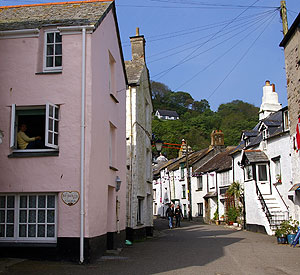 It was very early in the season but
by about 10 o'clock, you began to sense
the pattern of Polperro's everyday life. Buses would disgorge their Emmets,
who would then wind their way down, cameras clicking, souvenir shopping &
munching on an ice cream. It's fun to listen to the conversations as Germans
are followed by crowds from Tyne & Wear & then a bunch of Aussies. (What
he isn't telling you is that Frank found four upstanding German citizens by
the quay side. He took their camera forcibly from them and proceeded
to take their picture whether they wanted it or not. They were not
amused! He then proceeded to give them directions, in fluent German
(yeah right!!) to the railway station. Unfortunately there
isn't one in Polperro!! The German Embassy are still requesting any news!!
Cynth)
It was very early in the season but
by about 10 o'clock, you began to sense
the pattern of Polperro's everyday life. Buses would disgorge their Emmets,
who would then wind their way down, cameras clicking, souvenir shopping &
munching on an ice cream. It's fun to listen to the conversations as Germans
are followed by crowds from Tyne & Wear & then a bunch of Aussies. (What
he isn't telling you is that Frank found four upstanding German citizens by
the quay side. He took their camera forcibly from them and proceeded
to take their picture whether they wanted it or not. They were not
amused! He then proceeded to give them directions, in fluent German
(yeah right!!) to the railway station. Unfortunately there
isn't one in Polperro!! The German Embassy are still requesting any news!!
Cynth)
These bus loads of tourists all need postcards, crab sandwiches, Cornish
pixies (for luck), a lamb & mint Pasty (well I did, at least twice!) & LOTS
of Cornish cream teas. Their many needs are catered for in many small shops.
Old fashioned sweets, places for ladies to buy clothes and jewellery & more cafes than you can shake a stick
at (be careful with your stick shaking, it gets VERY crowded, even off
season). Us cottage renters have a
choice of two outlets selling any of the provisions we forgot to bring. All
the art shop/galleries seem to sell paintings in blue, the pubs who want to
be thought of as "better" have seafood on their menus, all lovingly
described, as if its all being cooked by Rick Stein.
Right in the centre of the village, the Big Green has been taken over by a pair of nesting swans. Someone is leaving water & providing the nest with fresh straw. They don't seem to be bothered by us humans, although the thrushes, trying to nick some of their food, cause them some annoyance!
Across from our cottage is a very nice museum that charges very little & is packed with information. Its full of really good early photographs & is well worth a visit. It tells the story of Polperro & smuggling, and being a lad, I loved the detailed models of ships & the cutlass that belonged to Robert Mark, a crewman shot at sea from a Revenue vessel. There are details of Zephaniah Job (known as the Smugglers' Banker) & Robert Jeffery, pressed ganged & cast ashore in 1807. All fascinating stuff!
We brought the day to a close with a return visit to our Polish friends in the fish and chip shop next door to give us the energy to face the packing for our return journey. Then...surprise surprise..Frank answered a knock on the door, and thinking it was the housekeeper, called "Come on in Kim." But no, it was none other than Tasha, a great friend from our website. Being phobic about photographs, we'd never seen Tash before. It was such a lovely surprise to meet her and her husband and daughter. The packing came to an abrupt halt while we all shot off to the pub. The secret is, we now have their photograph but are not allowed to publish on pain of death! Bob is a wildfowler and has a huge gun so Frank took it all very seriously...not!
The return journey
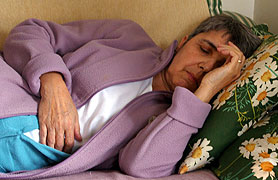
 The
Saturday was marred by us being blocked in by some local car owners. Of
course the people in the The Ship Inn denied all knowledge and of course, they didn't want to become embroiled in
any dispute. Luckily some kind locals gave us the information we needed and
Cynthia shot off at a pace I could only dream of. While I sat waiting in
the cottage, she sorted the whole thing out and we left only about 30 minutes
later than we should. In between the times we waited for people to turn up
(or not as it happened) we had a fabulous full breakfast at the "House on
the Props" pub. Really well cooked & a very reasonable price. It helped calm
us down & set us up for the journey back to the Midlands where we stayed
overnight again.
The
Saturday was marred by us being blocked in by some local car owners. Of
course the people in the The Ship Inn denied all knowledge and of course, they didn't want to become embroiled in
any dispute. Luckily some kind locals gave us the information we needed and
Cynthia shot off at a pace I could only dream of. While I sat waiting in
the cottage, she sorted the whole thing out and we left only about 30 minutes
later than we should. In between the times we waited for people to turn up
(or not as it happened) we had a fabulous full breakfast at the "House on
the Props" pub. Really well cooked & a very reasonable price. It helped calm
us down & set us up for the journey back to the Midlands where we stayed
overnight again.
Devon hospitality came to the fore once more. Cynthia's cousin Stephen, invited us to break our trip at his home in Wellington for a cuppa. It was most welcome & a pleasure to meet him and Jan his wife. Of course, we got the wrong postcode & Gladys took us (very accurately) to a field outside the town full of cows (very attractive Devon ones of course!). She redeemed herself when I managed to punch in the correct code! Somehow, it managed to sum up my relationship with her. She always got us there in an interesting fashion .... eventually ... in the end.
Links for information on this page:
The full story of Buckfast wine!
Polperro's village site
A fine smugglers history web site
Harbour view's web page
Jamaica Inn
St. Michael's Mount
Drake's Drum
